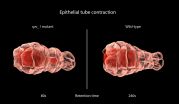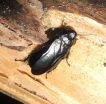Epithelial tube contraction
A new feedback mechanism for regulating contractility
2014-12-19
(Press-News.org) Researchers at the Mechanobiology Institute (MBI), National University of Singapore (NUS) have identified a novel mechanosensitive regulation of epithelial tube contraction. These findings are published on 19 December 2014 in Current Biology (Pei Yi Tan and Ronen Zaidel-Bar. Transient membrane localization of SPV-1 drives cyclical actomyosin contractions in the C. elegans spermatheca, Current Biology, 19 Dec 2014, doi: 10.1016/j.cub.2014.11.033)
Regulating tube constriction
Many of the fundamental processes of life rely on biological structures known as epithelial tubes. These tubes serve to transport various gases, liquids and cells around the body. With each breath, for example, epithelial tubes transport oxygen to the lungs. Our blood vessels, kidneys and pancreas, mammary, salivary and tear glands, are all essentially composed of epithelial tubes. However, these tubes are more than just a biological plumbing system. Instead, they are dynamic structures which must counter outward pressures to prevent their swelling or rupture. An intrinsic ability of epithelial tubes to constrict helps maintain their integrity. This constriction results from actomyosin contractility, a co-ordinated movement of filaments made of a protein known as actin, and a motor protein known as myosin. Problems in epithelial tube contractility are responsible for asthma, raised blood pressure and gastrointestinal disorders. Each one of these diseases affects millions of people worldwide, dramatically affecting their quality of life.
MBI scientists have discovered a feedback mechanism that regulates epithelial tube contractility in a living organism, the C. elegans nematode worm. C. elegans is a hermaphrodite, and can therefore reproduce by self-fertilization. Within the worm is a 'conveyor belt' of unfertilised eggs. During ovulation, a single egg is released into a structure known as the 'spermatheca', which is an accordion shaped tube that houses the sperm. Following fertilisation, an actomyosin based contraction of the tube expels the fertilised embryo into the uterus. This cycle is repeated approximately 150 times throughout the lifetime of the adult worm.
This contraction is similar to that observed in other epithelial tubes. The similarities led MBI Principal Investigator, Associate Professor Ronen Zaidel-Bar and graduate student Ms Tan Pei Yi to use the spermatheca as a model to study epithelial tube contraction. In doing so, a novel mechanism of regulation was identified, and a protein known as SPV-1 shown to maintain regular cycles of actomyosin contractility. In mutants lacking SPV-1 function, a hyperactive contractility was noted, with embryos propelled from the spermatheca prematurely.
Remarkably, it was the interplay between SPV-1 localization within the cell, and the shape of the cell membrane, that controlled tube contractility. In an empty spermatheca, SPV-1 attached to the folded, convoluted cell membranes where it acted as a protein roadblock preventing actomyosin contractility. However, as the spermathecal cells stretched upon entry of the egg, SPV-1 detached from the straightened membrane. With the roadblock removed, actomyosin contractility occured and a fertilised embryo was ejected into the uterus. Once the reproductive cycle was completed, the spermatheca collapsed, and SPV-1 re-localized to the folded membrane. However, when SPV-1 was mutated, it remained attached to the membrane irrespective of membrane curvature. In this case the actomyosin failed to contract, leading to the accumulation of multiple embryos in the spermatheca. This finding confirmed that SPV-1 is indeed mechanosensitive.
The elegant feedback system discovered in this study links the regulation of contraction to the shape and function of epithelial tubes via mechanical and biochemical signalling. It may also represent a universal mechanism that regulates contractility in other epithelial tubes, including those found throughout our bodies. Extending this mechanism to our current knowledge of contractility and understanding how it regulates human epithelial tube constriction could lead to novel treatments for diseases such as asthma or cardiovascular disease.
INFORMATION:
[Attachments] See images for this press release:

ELSE PRESS RELEASES FROM THIS DATE:
2014-12-19
Over the past decade, ocean acidification has received growing recognition not only in the scientific area. Decision-makers, stakeholders, and the general public are becoming increasingly aware of "the other carbon dioxide problem". It is time to reflect on the successes and deficiencies of ocean acidification research and to take a look forward at the challenges the fastest growing field of marine science is facing. In the January issue of the journal Nature Climate Change Ulf Riebesell, professor for Biological Oceanography at GEOMAR Helmholtz Centre for Ocean Research ...
2014-12-19
Bremerhaven/Germany, 18 December 2014. Ingestion of microplastic particles does not mechanically affect marine isopods. This was the result of a study by biologists at the North Sea Office of the Alfred Wegener Institute, Helmholtz Centre for Polar and Marine Research (AWI) that was published recently in the journal Environmental Science and Technology. The study marks the launch of a series of investigations aimed at forming a risk matrix on the sensitivity of different marine species to microplastic pollution.
Uptake of large plastic items by birds and fish may cause ...
2014-12-19
In a recent study from Lund University in Sweden, researchers have used new technology to study extremely fast processes in solar cells. The research results form a concrete step towards more efficient solar cells.
The upper limit for the efficiency of normal solar cells is around 33 per cent. However, researchers now see a possibility to raise that limit to over 40 per cent, thereby significantly improving the potential of this energy source.
The experiments in the present study involved 'juggling' on quantum level with photons, i.e. light particles, and electrons. ...
2014-12-19
In everyday life, the global positioning system (GPS) can be employed to reliably determine the momentary location of one en route to the desired destination. Scientists from the Institute of Physical and Theoretical Chemistry of the University of Bonn have now developed a molecular "GPS" with which the whereabouts of metal ions in enzymes can be reliably determined. Such ions play important roles in all corners of metabolism and synthesis for biological products. The "molecular GPS" is now being featured in the journal Angewandte Chemie.
There would be no life on our ...
2014-12-19
Bethesda, MD (Dec. 19, 2014) -- A new formulation of oral budesonide suspension, a steroid-based treatment, is safe and effective in treating pediatric patients with eosinophilic esophagitis (EoE), according to a new study in Clinical Gastroenterology and Hepatology, the official clinical practice journal of the American Gastroenterological Association. Eosinophilic esophagitis is a chronic immune system disease caused by a buildup of white blood cells in the lining of the esophagus. This build up, which is a reaction to food, allergens or acid reflux, can inflame or injure ...
2014-12-19
The changes can be measured, but their reasons were unknown. For several decades, scientists have carefully observed that the oxygen minimum zones (OMZ) in the tropical oceans are expanding. These zones are a paradise for some specially adapted microorganisms, but for all larger marine organisms such as fish and marine mammals they are uninhabitable. Thus, their expansion has already narrowed down the habitat of some fish species.
Marine scientists from the GEOMAR Helmholtz Centre for Ocean Research Kiel and the Kiel Collaborative Research Centre (Sonderforschungsbereich, ...
2014-12-19
PITTSBURGH--University of Pittsburgh researchers have shared their findings from three studies related to shale gas in a recent special issue of the journal Energy Technology, edited by Götz Veser, the Nickolas A. DeCecco Professor of Chemical and Petroleum Engineering in Pitt's Swanson School of Engineering.
In the special issue focusing on shale gas, Pitt faculty authors look at "smart wells" that use wireless communication, wastewater management, and information gaps between legislators, regulators, industry representatives, researchers, and the public on the ...
2014-12-19
Scientists from the Southwest University, Chongqing, China have found a new species and a new subspecies of cockroach. What makes these creepy crawlies distinctive from the cockroaches most of us know is that they don't infest human houses, on the contrary they prefer to live a hermit life drilling logs, hidden away from human eyes. The study was published in the open access journal ZooKeys.
Out of around 4,600 species worldwide, only 30 are the cockroaches associated with human habitats that gives the bad fame of these creatures. The representatives of the genus Panesthia, ...
2014-12-19
Most parents are not surprised by the irregularity of a newborn infant's sleep patterns, but by six months or so many parents wonder if something is wrong with their baby or their sleeping arrangements if the baby is not sleeping through the night. Healthcare providers, specifically nurse practitioners, can help parents understand what "normal" sleep patterns are for their child, according to researchers.
"Nurse practitioners are at the frontline of healthcare," said Robin Yaure, senior instructor of human development and family studies, Penn State Mont Alto. "They are ...
2014-12-19
Jacksonville, FL (December 19, 2014) - Investigators have found that young children with type 1 diabetes (T1D) have slower brain growth compared to children without diabetes. A new study, published in the December issue of Diabetes, now available ahead of print, suggests that continued exposure to hyperglycemia, or high blood sugars, may be detrimental to the developing brain. The research was supported by the National Institutes of Health (NIH).
"Our results show the potential vulnerability of young developing brains to abnormally elevated glucose levels, even when ...
LAST 30 PRESS RELEASES:
[Press-News.org] Epithelial tube contraction
A new feedback mechanism for regulating contractility


